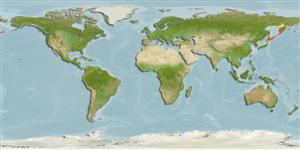Teleostei (teleosts) >
Perciformes/Cottoidei (Sculpins) >
Cottidae (Sculpins)
Etymology: Myoxocephalus: Greek, myos = muscle, and also, mouse + Greek, kephale = head (Ref. 45335).
Eponymy: Johann Friedrich (Fedor Fedorovich) von Brandt (1802–1879) was a German zoologist, surgeon, pharmacologist and botanist who moved to Russia (1831). [...] (Ref. 128868), visit book page.
More on author: Steindachner.
Environment: milieu / climate zone / depth range / distribution range
Ecology
Marine; demersal; depth range 0 - 140 m (Ref. 50550), usually 25 - 50 m (Ref. 56527). Temperate
Northwest Pacific: Hokkaido to the northern Sea of Japan and the Sea of Okhotsk.
Size / Weight / Age
Maturity: Lm ? range ? - ? cm
Max length : 42.0 cm TL male/unsexed; (Ref. 56527); max. published weight: 1.2 kg (Ref. 56527)
Short description
Identification keys | Morphology | Morphometrics
Inhabits seaweed beds, or waters shallower than 60 m (Ref. 41299).
Life cycle and mating behavior
Maturity | Reproduction | Spawning | Eggs | Fecundity | Larvae
Masuda, H., K. Amaoka, C. Araga, T. Uyeno and T. Yoshino, 1984. The fishes of the Japanese Archipelago. Vol. 1. Tokai University Press, Tokyo, Japan. 437 p. (text). (Ref. 559)
IUCN Red List Status (Ref. 130435: Version 2024-1)
Threat to humans
Harmless
Human uses
Tools
Special reports
Download XML
Internet sources
Estimates based on models
Preferred temperature (Ref.
123201): 1.5 - 10.2, mean 2.5 °C (based on 14 cells).
Phylogenetic diversity index (Ref.
82804): PD
50 = 0.5000 [Uniqueness, from 0.5 = low to 2.0 = high].
Bayesian length-weight: a=0.00589 (0.00281 - 0.01234), b=3.15 (2.97 - 3.33), in cm total length, based on LWR estimates for this (Sub)family-body shape (Ref.
93245).
Trophic level (Ref.
69278): 3.6 ±0.2 se; based on size and trophs of closest relatives
Resilience (Ref.
120179): Low, minimum population doubling time 4.5 - 14 years (Assuming tmax>10; K=0.49-0.62).
Fishing Vulnerability (Ref.
59153): Low to moderate vulnerability (32 of 100).
